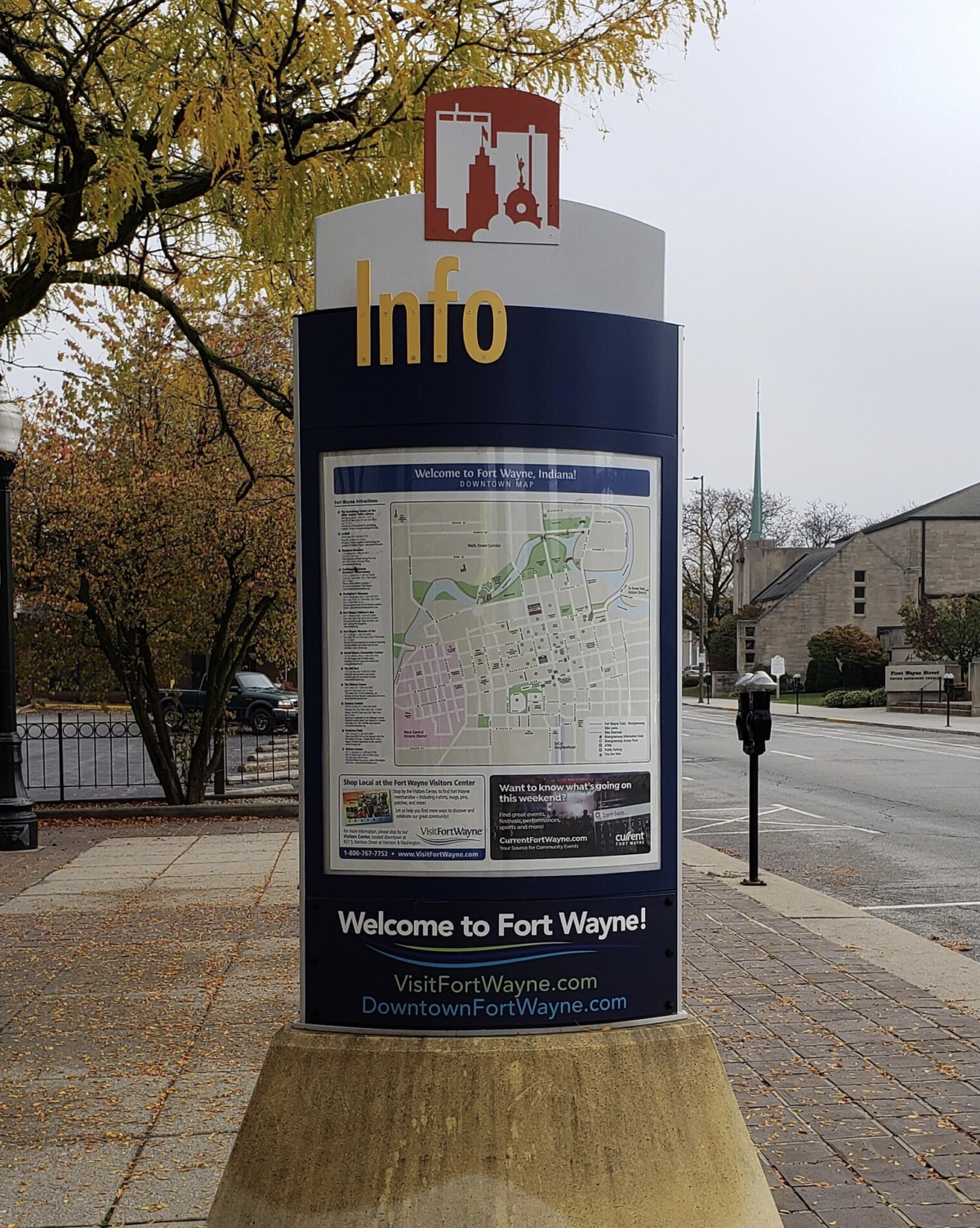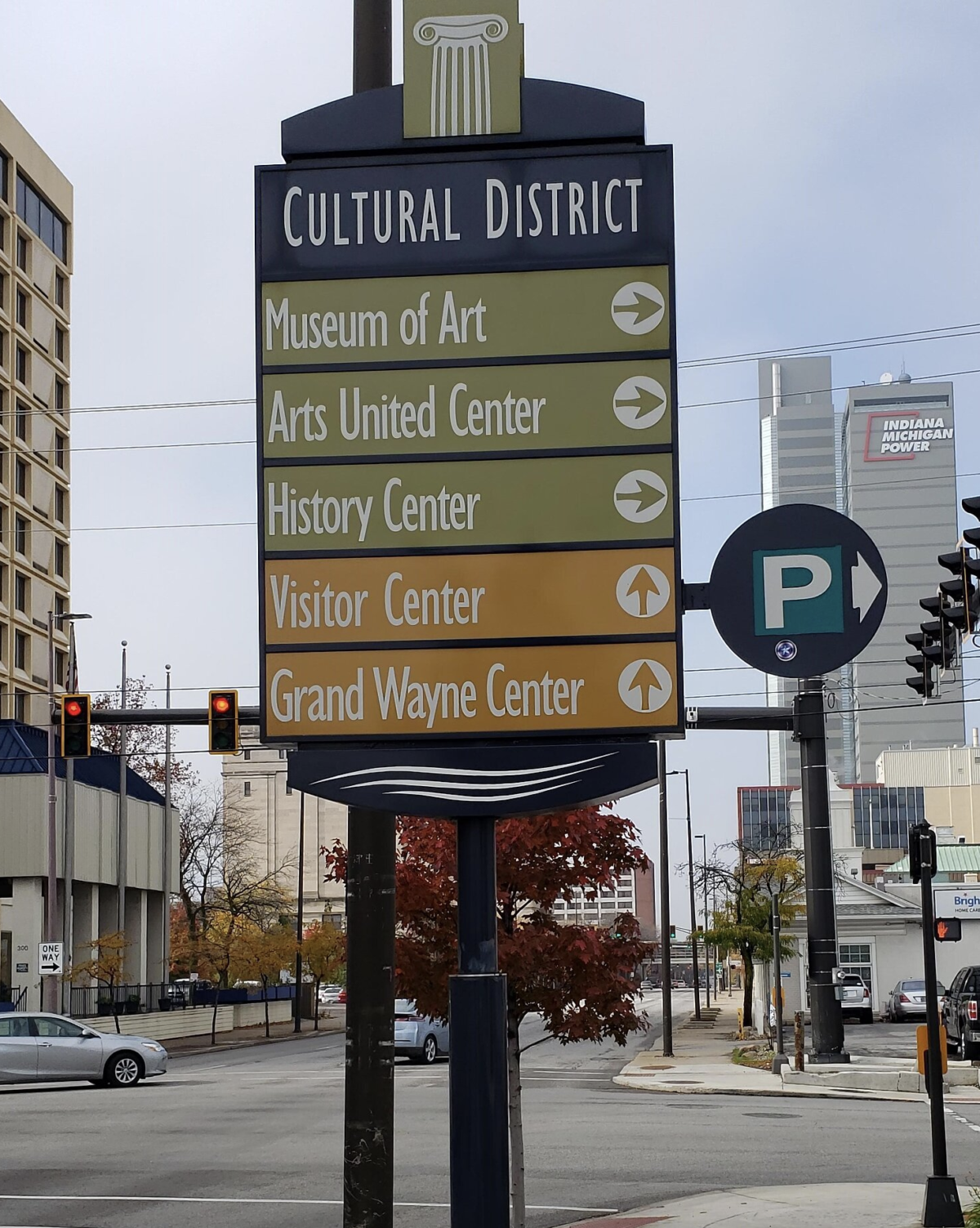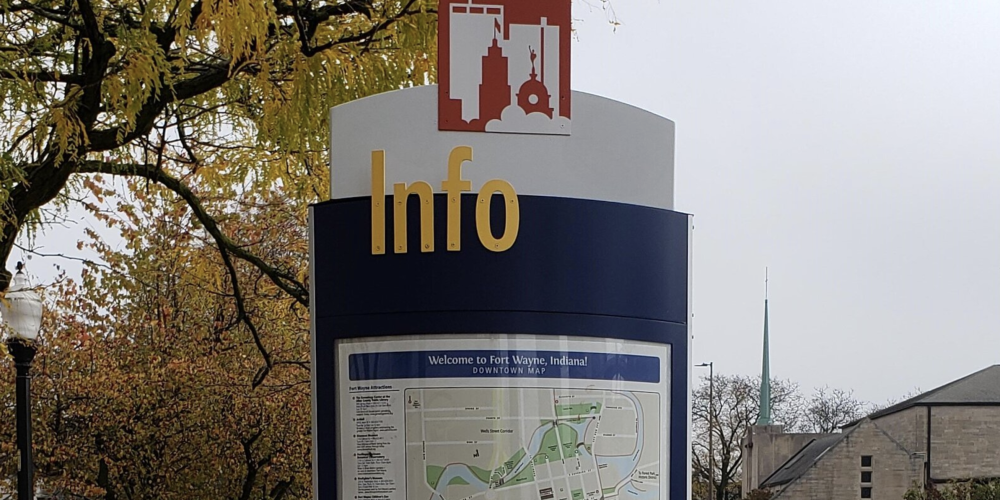Fort Wayne, particularly Downtown, has developed a great deal in the last dozen years. And with this physical growth comes a need for a strategy around driving residents and tourists alike to new and established attractions and destinations.
Downtown Fort Wayne (previously known as the Downtown Improvement District) and the City of Fort Wayne are currently engaged in a process to review and ultimately update signs and kiosks to make them attractive, current and relevant. The city has secured supplemental grant funding that will cover the costs of design and implementation, though the size and scope of the project are still to be determined.
Enter wayfinding, a process that Downtown Fort Wayne President/CEO Michael Galbraith says helps define a city’s sense of place.
According to the Global Design Cities Initiative, “Wayfinding systems should encourage walking and transit usage by providing multimodal information and adopting the pedestrian perspective. Wayfinding works with other visual cues to help people orient themselves and provide confidence in navigating the geography of a city. Wayfinding can increase people’s comfort in choosing to walk when they understand a destination proximity.”
Galbraith says that’s what they hope to accomplish by updating and installing new signs around the city.
Why now and what does this project mean to the city’s future as a tourist destination and place to call home? Galbraith says he feels strongly about both elements.
“I think the last time (these signs) were majorly refreshed and installed was in 2011,” he says. “So that means that it was planned for in 2009 and 2010. A lot has changed in the city since then. Some of the signs may not have aged as well. And businesses or institutions that were there might be gone, too.”
Innovations have changed the game, too in the last decade or so. For example, the public can now engage with touchscreen kiosks for a more interactive experience. While he says the particulars will depend on the budget and final design, Galbraith would like to up the ante on the tech side for the sake of modernizing.
“We’re seeing elsewhere — in other cities — the ability for people to interact and sort of customize just like you would on your phone to be able to say ‘here’s where the information is that I want to know,” he says. “Each person is going to want to know different information. So if somebody wants to know when the performance is at Arts United Center, that there’s something that you should be able to find (there).”
Galbraith says this effort is part of a larger strategy to remain competitive on the national stage. While Fort Wayne’s placemaking stature was impressive in 2011, that time has come and gone. Galbraith says it’s time to “step it up” so that the city continues to expand Fort Wayne’s economy by way of tourism dollars and other key metrics.
The project’s impact, though maybe not a direct one, might be realized over time.
“Getting people to go to places where they spend money certainly (matters),” he says. “And if they can’t find The Landing, or they can’t find their way back to the convention center, or leave a hotel to go find the Fort Wayne Children’s Zoo, that’s money that’s not flowing into the economy.”
Speaking of attractions, Galbraith says they’re currently looking at existing inventory to take stock of which signs are in the mix. There’s also some red tape involved. For example, Galbraith says they need to coordinate with different entities like the federal Department of Transportation, the state Department of Transportation and the local planning organization, to understand the limitations.
The specific elements will vary according to the sign’s context.
“You need to have different sign experiences based on who your audience is going to be,” he says. “So if you have somebody that’s walking along there, there needs to be one sign experience. Somebody’s coming along the highway at 75 miles an hour (will require) a different sign experience than somebody that’s going to be able to come up to a map on a kiosk.”
While taking inventory of current attractions, they’re also paying attention to future attractions that could impact where people want to go.
On December 19, members of the Fort Wayne City Council unanimously approved the city’s first Designated outdoor Refreshment Area (DORA). This move allows people to purchase alcoholic beverages from approved businesses within the DORA and carry them outside to be consumed within specified boundaries. As WFFT reported, “the DORA will stretch from Promenade Park to Parkview Field, and include The Bradley Hotel, the Grand Wayne Center, and The Landing.”
While the City is still awaiting approval from the Indiana Alcohol & Tobacco Commission, both city officials and workers in the restaurant industry told WANE it would be a huge development for Fort Wayne and its tourism and dining establishments within the DORA.
As of mid-December, only four other Indiana cities have DORAs approved by the state– Kirklin, Lawrenceburg, Shelbyville, and Yorktown.
While not directly related to developments in wayfinding across Fort Wayne, the approval of a DORA in Downtown Fort Wayne could heavily support the goal of elevating the city’s stature on the national stage.
When it comes to wayfinding and aesthetics, Galbraith says that appearance matters just as much as the functional facet. He says working with design consultants will help them elevate the city’s stature in terms of presentation. They also plan to look to other cities for inspiration on concepts. In the meantime, they’re looking forward to receiving design concepts from the Michigan-based firm Corbin Design by the spring and installing several units by the end of 2024.
Hayley Bondi, urban designer and landscape architect at the City of Fort Wayne agrees with his estimation of the significance of both form and function. She emphasizes that the signs are more than eye candy — they’re economic development tools on a micro level.
“The current wayfinding signage that we have is outdated, design-wise,” she says. “And while we have beautiful street trees, a lot of our fruit trees are currently blocking some of our wayfinding signage. So it doesn’t make it incredibly useful for visitors to come to the city when they’re trying to find the place.”
Bondi says Fort Wayne welcomes up to a million visitors a year, who spend an estimated $800 million on food, lodging, retail, and entertainment.
“We want to make sure that we’re actually directing them to places they want to go easily,” she says.
It’s not just tourists who are the end users. She says they often hear from the public that they don’t know where to park Downtown. With that in mind, they plan to introduce parking branding to help guide residents when visiting the city’s core.
Bondi says she looks forward to helping better market the city’s rich and diverse array of attractions through signage that communicates who we are as a city.
In her words, “I’m looking forward to hopefully something that looks clean and airy and represents Fort Wayne for at least another 20 years.”


Courtesy of City of Fort Wayne
This feature is by Lauren Caggiano. This story is made possible by support from Downtown Fort Wayne in partnership with Input Fort Wayne.

